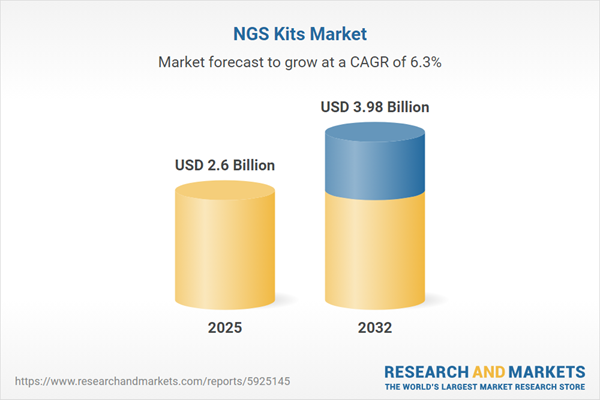Speak directly to the analyst to clarify any post sales queries you may have.
The next generation sequencing kits market is evolving rapidly, shaped by accelerated technology breakthroughs and the changing needs of research and diagnostics. Senior decision-makers can harness these shifts to optimize growth, refine operational agility, and enable more effective cross-sector partnerships.
Market Snapshot: Next Generation Sequencing Kits Market Overview
In 2024, the next generation sequencing kits market is valued at USD 2.44 billion, with projections to reach USD 3.98 billion by 2032, indicating a compound annual growth rate (CAGR) of 6.28%. This industry growth is propelled by high adoption rates of advanced sequencing technologies across a variety of applications, including both pure scientific research and clinical diagnostics. Laboratories are constantly reworking protocols to meet throughput and flexibility requirements. Ongoing investments drive further innovation, while evolving regulations shape strategies for global market access, competitive entry, and supply partnerships.
Scope & Segmentation of the Next Generation Sequencing Kits Market
- Product Types: Library preparation kits improve efficiency throughout sequencing workflows, accommodating amplicon, RNA, and whole genome sequencing, and streamlining steps from sample to analysis.
- Product Types: Sequencing kits are developed for compatibility with various laboratory platforms, supporting both nanopore and synthesis-based methods commonly used in research and clinical laboratories.
- Product Types: Template preparation kits employ bridge PCR and emulsion PCR to provide flexibility for distinct workflow requirements and a broad range of laboratory settings.
- Applications: Exome and targeted sequencing kits are integral for diagnostics and research, leveraging PCR and hybridization techniques for precise data generation across multiple study types.
- Applications: Transcriptome analysis kits enable high-throughput and single-cell genomic profiling, offering valuable insights for fundamental research and applied genomics projects.
- End Users: Academic institutions, clinical labs, and organizations in the pharmaceutical or biotechnology sectors utilize these kits to advance research objectives, enhance diagnostics, and achieve operational efficiencies.
- Sequencing Technologies: Solutions encompass nanopore sequencing, sequencing by ligation, and sequencing by synthesis, providing adaptability for user-specific demands on speed, accuracy, and scale.
- Regions: The market spans the Americas, Europe, Middle East, Africa, and Asia-Pacific; adoption trends from countries such as China, India, Japan, Australia, and South Korea drive local developments and regional technology evolution.
- Featured Companies: Leading suppliers including Illumina, Thermo Fisher Scientific, Roche, Danaher, MGI Tech, Agilent Technologies, PerkinElmer, Takara Bio, Oxford Nanopore Technologies, and Twist Bioscience influence global trends and competitive strategies.
Key Takeaways for Senior Decision-Makers
- Automation capabilities and improved sequencing chemistries support laboratories in raising throughput and data quality, aligning solutions to scientific and clinical demands.
- Broader kit portfolios allow organizations to address specialized workflows across areas like clinical diagnostics, agriculture, and basic molecular research.
- Modular design in kit architecture enables research facilities to adapt swiftly to changes in study direction or funding, supporting strategic agility.
- Strengthened collaboration across manufacturers, distributors, and end users drives faster development of regulatory-ready products and smoother workflow integration into existing operations.
- Regulatory adjustments and higher domestic manufacturing capacities ease compliance and facilitate improved market access within key regions.
- Procurement strategies increasingly focus on diverse supply chains, enabling organizations to reinforce resilience and uphold strict compliance standards as distribution networks grow.
Tariff Impact: Navigating Supply Chain and Cost Challenges
Recent US tariffs on imported sequencing kit components have prompted manufacturers to emphasize local sourcing and expand domestic production capacities. These actions are stabilizing prices and supporting supply continuity but demand more rigorous oversight to maintain compliance and product standards. As procurement models evolve, building out regional manufacturing and validation capabilities has become an essential strategy to secure kit availability under variable supply conditions.
Methodology & Data Sources
This analysis integrates leading secondary research from scientific literature and industry publications, complemented by direct interviews with sector executives, diagnostic lab managers, and supply chain specialists. By merging quantitative data with qualitative insights, the assessment delivers a robust view of the current state and outlook of the next generation sequencing kits market.
Why This Report Matters
- Equips senior leaders with strategies to align with rapidly advancing sequencing kit technologies, evolving regulatory frameworks, and new market access models.
- Offers targeted segmentation and competitive details to guide decisions on global expansion, new product planning, and optimization of current portfolios.
- Highlights operational agility and partnerships as vital for sustaining performance and resilience in increasingly complex market environments.
Conclusion
Strategic flexibility and collaboration are essential to remain competitive in the next generation sequencing kits market. Organizations focusing on ongoing innovation and responsive operations will be best prepared to capture emerging opportunities and adapt to sector changes.
Additional Product Information:
- Purchase of this report includes 1 year online access with quarterly updates.
- This report can be updated on request. Please contact our Customer Experience team using the Ask a Question widget on our website.
Table of Contents
3. Executive Summary
4. Market Overview
7. Cumulative Impact of Artificial Intelligence 2025
Companies Mentioned
The companies profiled in this NGS Kits market report include:- Illumina, Inc.
- Thermo Fisher Scientific Inc.
- Roche Holding AG
- Danaher Corporation
- MGI Tech Co., Ltd.
- Agilent Technologies, Inc.
- PerkinElmer, Inc.
- Takara Bio Inc.
- Oxford Nanopore Technologies plc
- Twist Bioscience Corporation
Table Information
| Report Attribute | Details |
|---|---|
| No. of Pages | 195 |
| Published | October 2025 |
| Forecast Period | 2025 - 2032 |
| Estimated Market Value ( USD | $ 2.6 Billion |
| Forecasted Market Value ( USD | $ 3.98 Billion |
| Compound Annual Growth Rate | 6.2% |
| Regions Covered | Global |
| No. of Companies Mentioned | 11 |









